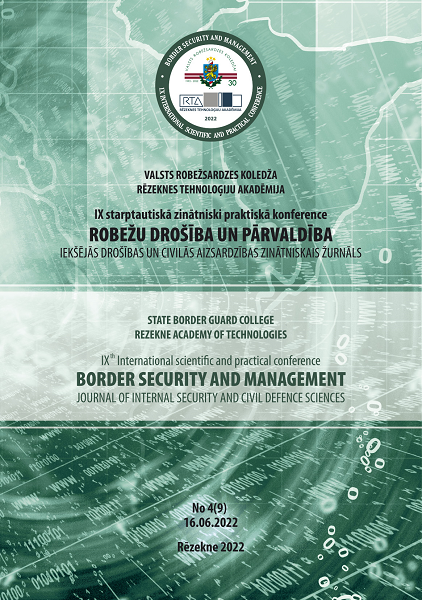EUROPEAN BORDER AND COAST GUARD STANDING CORPS CATEGORY 1 BASIC TRAINING TOPICALITIES IN ENSURING THE EU BORDER SECURITY
DOI:
https://doi.org/10.17770/bsm.v4i9.7049Keywords:
basic training, common core curriculum, Frontex, standing corpsAbstract
Establishment of the European Border and Coast Guard Standing Corps Category 1 has been recently the most visible change in the European approach in the management of the EU external borders. The political decision of the EU to have its own law enforcement officers for border protection and migration management and return-related tasks, has manifested a paradigm shift, also in training and education. The European Border and Coast Guard Agency (Frontex) has a leading role in capacity building, for example in terms of providing training for the members of the Category 1. The Agency Regulation provides a legal basis for the statutory staff of the Standing Corps, in particular highlighting the importance of training based on common values and culture, and respect of fundamental rights. The European dimension of the Standing Corps training is underpinned by the legal and ethical responsibilities of the Agency to ensure that the members of the Standing Corps are well trained and fully prepared to perform tasks with executive powers. The main aim of the paper is to explore the establishment of standing corps from the perspective of basic training. The context presented supports the thesis that the initial training serves as the foundation of public agreement and investment for common safety and security. The paper builds upon hands-on experience of the author and draws the general conclusion to prove the thesis based on the legal instruments presented and implementation of basic training editions.References
BASIC TRAINING PROGRAMME FOR THE EUROPEAN BORDER AND COAST GUARD STANDING CORPS IN THE EU (2019). Warsaw, Frontex.
COMMON CORE CURRICULUM FOR BORDER AND COAST GUARD BASIC TRAINING IN THE EU (2017) Warsaw, Frontex.
COMMON CORE CURRICULUM FOR BORDER AND COAST GUARD MID-LEVEL MANAGEMENT TRAINING IN THE EU (2019) Warsaw, Frontex.
KIRKPATRICK J. D. & KIRKPATRICK W. K. (2016) Kirkpatrick's Four Levels of Training Evaluation. Aleksandria USA, ATD Press
SCHEIN, E. H. (1978) What you need to know about organizational culture, Training and Development Journal, January 1986; 30-33. Available from: https://cmapspublic.ihmc.us/rid=1GSGS9M3P-8BFNGM-Q8Z/what%20you%20need%20to%20know%20about%20org%20culture%20schein.pdf [Accessed on 29th May 2021].
REGULATION (EU) 2016/399 OF THE EUROPEAN PARLIAMENT AND OF THE COUNCIL OF 9 MARCH 2016 ON A UNION CODE ON THE RULES GOVERNING THE MOVEMENT OF PERSONS ACROSS BORDERS (SCHENGEN BORDERS CODE); OJ L 77/1 23.3.2016
REGULATION (EU) 2019/1896 OF THE EUROPEAN PARLIAMENT AND OF THE COUNCIL OF 13 NOVEMBER 2019 ON THE EUROPEAN BORDER AND COAST GUARD REPEALING REGULATIONS (EU) NO 1052/2013 AND (EU) 2016/1624 REGULATION (EU) 2019/1896 OF THE EUROPEAN PARLIAMENT AND OF THE COUNCIL OF 13 NOVEMBER 2019 ON THE EUROPEAN BORDER AND COAST GUARD AND REPEALING REGULATIONS (EU) NO 1052/2013 AND (EU) 2016/1624; PE/33/2019/REV/1; OJ L 295, 14.11.2019
TUCKMAN, B. W. (1965). Developmental sequence in small groups. Psychological Bulletin. 63 (6), 384–399.
WAWRZUSISZYN A. (2011). „Pojęcie i istota bezpieczeństwa”, [in:] Zarządzanie kryzysowe. Teoria, praktyka, konteksty, badania, pod red. naukową J. Stawnickiej, B. Wiśniewskiego, R. Sochy, Wydawnictwo Wyższej Szkoły Policji w Szczytnie.
WAWRZUSISZYN A. (2012). „Współczesne zagrożenia bezpieczeństwa człowieka”, [in:] Sytuacje krytyczne a stres, pod red. naukową B. Wiśniewskiego i B. Kaczmarczyk, Wydawnictwo Wyższej Szkoły Administracji w Bielsko-Białej.






